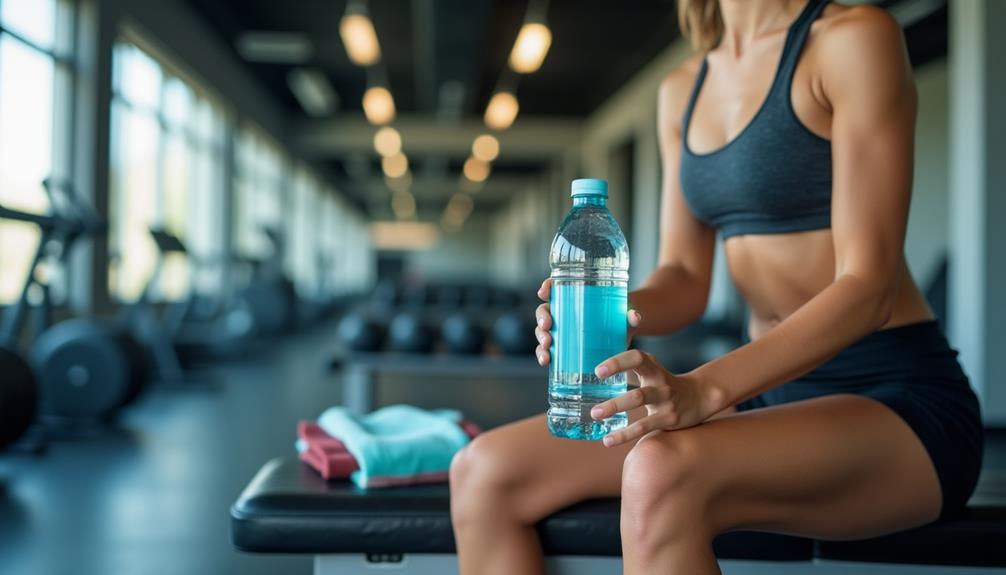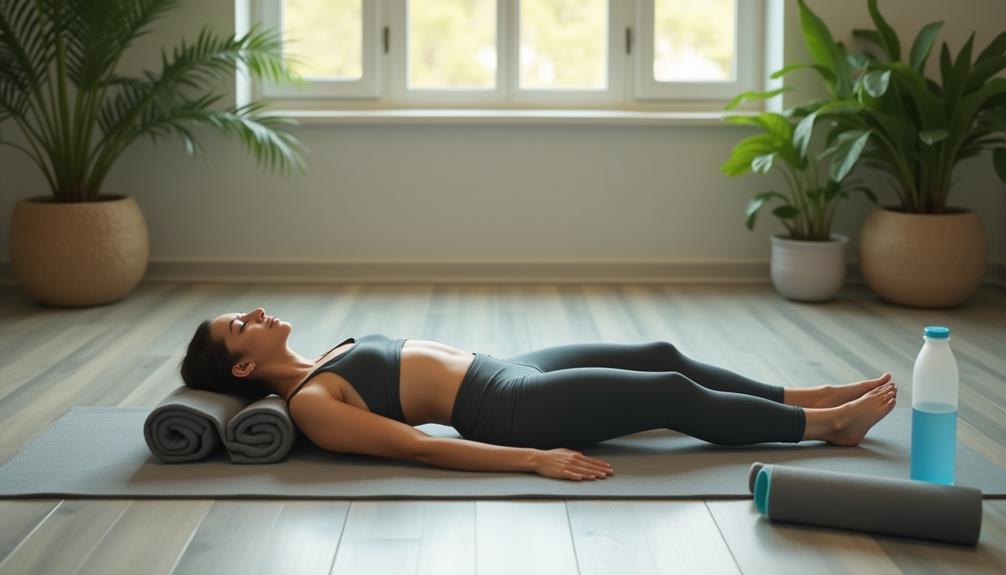To relieve muscle soreness after hypertrophy training, follow these three essential tips. First, stay hydrated by drinking plenty of water before, during, and after your workouts. Good hydration helps your muscles recover effectively. Second, incorporate active recovery. Engage in low-intensity exercises, like walking or cycling, for 20-30 minutes on rest days to improve blood flow and reduce soreness. Ultimately, utilize foam rolling. Spend 10-15 minutes rolling out tight muscle groups, focusing on larger muscles first. This technique enhances flexibility and reduces discomfort. By applying these strategies, you'll speed up recovery and feel better sooner. Discover more insights to optimize your routine!
Core Insights
- Stay properly hydrated by drinking water before, during, and after workouts to aid in muscle recovery.
- Incorporate active recovery like walking or cycling for 20-30 minutes to enhance blood flow and relieve soreness.
- Utilize foam rolling on larger muscle groups post-workout to reduce tightness and improve flexibility.
- Pay attention to your body; listen to signals of fatigue and adjust activity intensity accordingly for optimal recovery.
- Consider adding coconut water for its electrolytes and low sugar content to support hydration and recovery.
Stay Hydrated

Aim to drink water before, during, and after your workouts. Consider carrying a water bottle to make it easier. You should also pay attention to your body's signals; if you're feeling thirsty, it's time to hydrate. For ideal hydration, you might want to try coconut water brands that are rich in electrolytes and have minimal added sugars. These natural options can provide excellent post-workout recovery benefits.
Electrolytes, like sodium and potassium, play a crucial role too. If you've had an intense session, consider a drink that contains electrolytes to restore balance. Remember, proper hydration isn't just about quenching thirst; it's a fundamental factor in effective muscle recovery.
Incorporate Active Recovery

Incorporating active recovery into your training routine can greatly enhance muscle soreness relief after hypertrophy workouts. Active recovery involves engaging in low-intensity exercises that promote blood flow without putting additional strain on your muscles.
Consider activities like walking, cycling, or swimming. These exercises help flush out metabolic waste, delivering nutrients to your muscles for quicker recovery. For more targeted relief, you can also use foam rollers to perform self-myofascial release on specific muscle groups, which can help alleviate tension and improve flexibility.
Aim for about 20-30 minutes of active recovery on your rest days. This way, you maintain movement and prevent stiffness while allowing your muscles to heal.
Listen to your body; if you feel fatigued, adjust the intensity. By integrating active recovery, you'll likely notice a reduction in soreness and an improvement in your overall performance.
Utilize Foam Rolling

Begin with the larger muscle groups, like your quads and hamstrings. Slowly roll over each area, pausing on tight spots for 20 to 30 seconds. Apply moderate pressure, but don't go too hard—discomfort is normal, but pain isn't. For best results, consider using a deep tissue roller designed specifically for intense muscle work. These rollers often have textured surfaces to target deeper layers of muscle tissue more effectively.
Aim to foam roll for about 10 to 15 minutes post-workout. Consistent use can significantly reduce soreness and improve flexibility. Remember, it's an important part of your recovery routine, so make it a habit!
Frequently Asked Questions
How Long Does Muscle Soreness Typically Last After Hypertrophy Training?
Muscle soreness usually lasts between 24 to 72 hours after training. It depends on various factors like intensity and individual recovery. You'll find it often decreases greatly as your body adapts to your workout routine.
Can Nutrition Help Reduce Muscle Soreness Effectively?
Yes, nutrition can effectively reduce muscle soreness. You'll benefit from consuming protein to repair muscles and antioxidants to combat inflammation. Staying hydrated also helps your body recover faster, so don't forget to drink plenty of water!
Are There Specific Stretches That Alleviate Soreness?
Imagine a tree bending gracefully in the wind. You can stretch your muscles similarly, with gentle moves like hamstring stretches and shoulder rolls. It'll help ease soreness, keeping your body feeling grounded and resilient.
When Should I Consider Seeing a Doctor for Soreness?
If your soreness persists beyond a week, worsens, or is accompanied by severe swelling, weakness, or fever, it's time to consult a doctor. Don't ignore these signs; they could indicate a more serious issue.
Does Sleep Quality Impact Muscle Recovery and Soreness?
Yes, sleep quality greatly impacts muscle recovery and soreness. When you prioritize restorative sleep, your body repairs itself more efficiently, reducing soreness and enhancing overall recovery. So, make sure you're getting enough quality rest each night.

